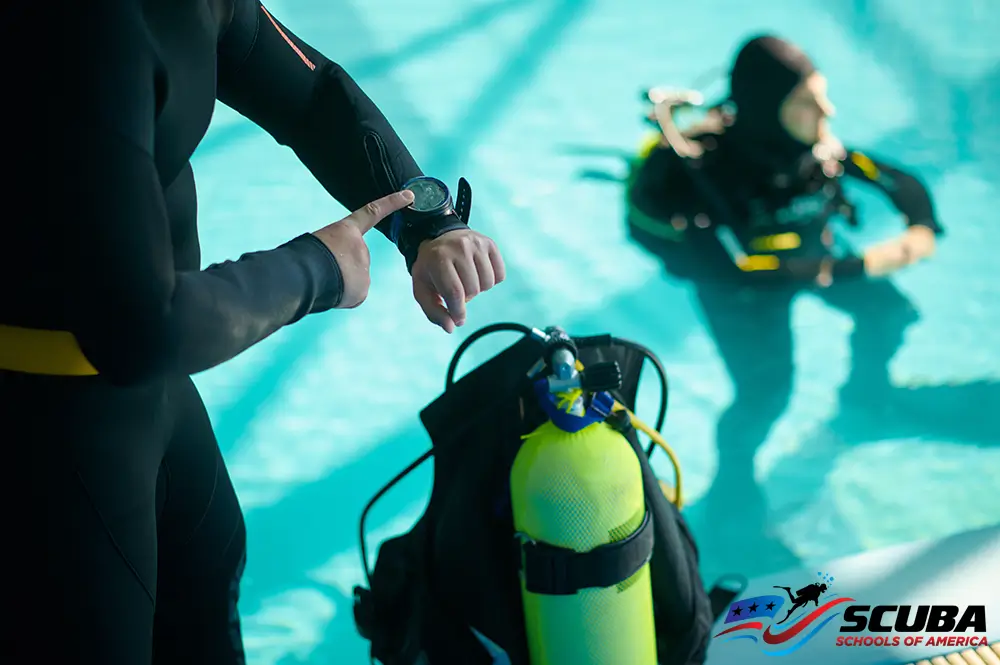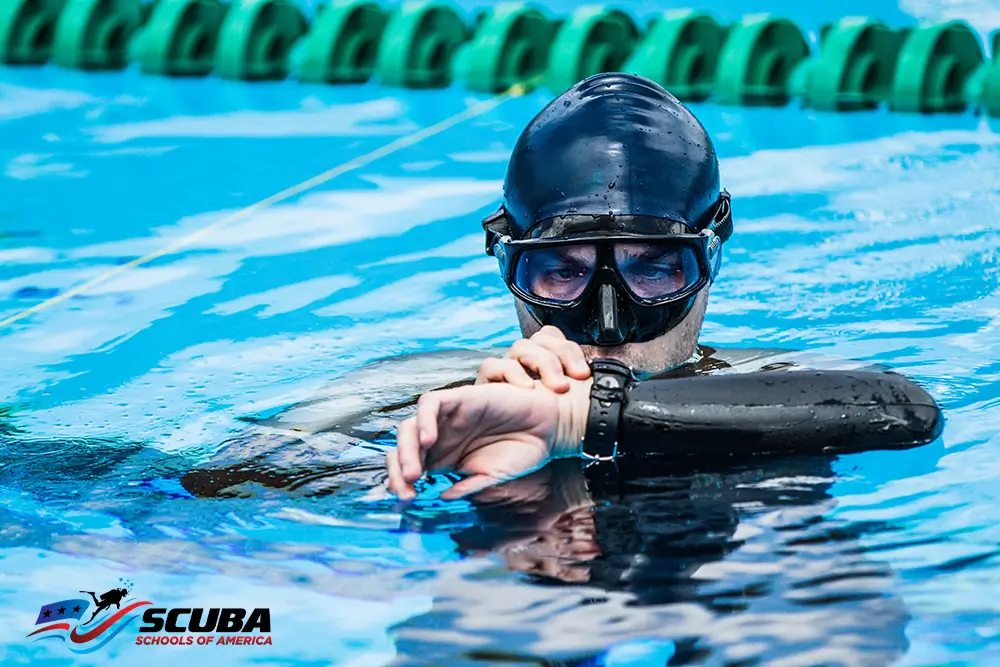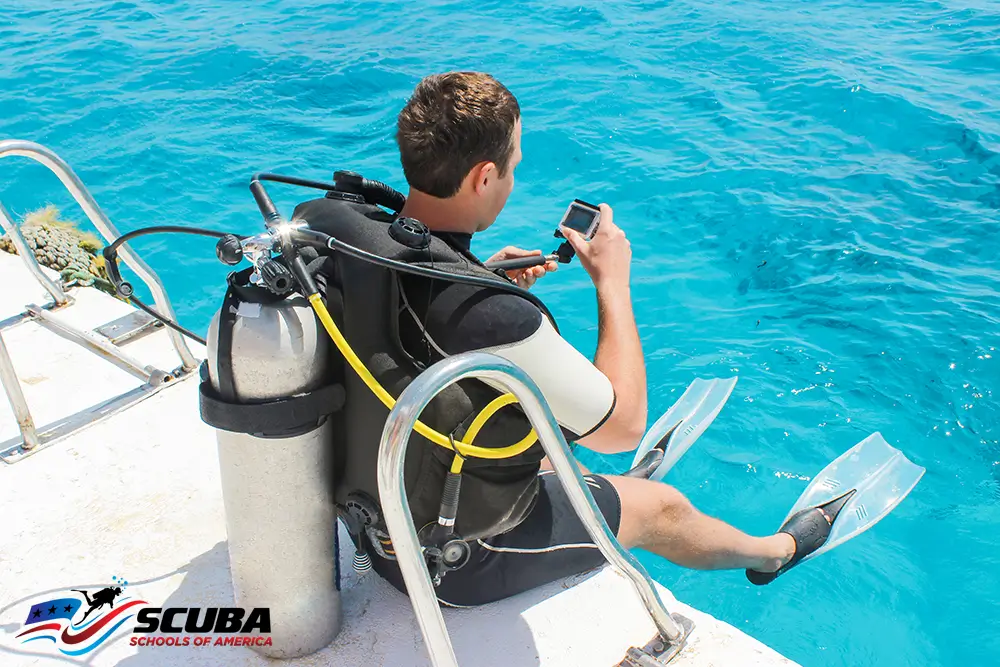In today’s world, it’s rare to find a Scuba diver heading into the water without the essential tool, a dive computer. Scuba diving opens doors to vibrant reefs, fascinating marine wildlife, and the exhilaration of exploring underwater environments. To fully experience and safely enjoy this underwater adventure, proper preparation and knowledge are critical.
Why Dive Computers Are Essential
Dive computers have transformed Scuba diving by becoming indispensable underwater companions. These sophisticated devices provide divers with real-time, accurate information, dramatically enhancing diving safety, comfort, and efficiency.
Whether you’re a novice diver exploring shallow reefs or an advanced diver planning multilevel dives, a dive computer is your ticket to safer and smarter diving.
What Exactly is a Dive Computer?
A dive computer is an advanced, wearable device that continually monitors crucial dive metrics such as depth, dive time, ascent rate, and water temperature. Utilizing state-of-the-art decompression algorithms, these devices calculate your no-decompression limits, ensuring you remain within safe parameters to avoid decompression sickness (commonly known as “the bends”).
Dive computers provide flexibility, allowing divers to safely adjust dive plans in real time based on their current underwater situation.
How Do Dive Computers Work
Dive computers continuously track your depth and time underwater, using advanced decompression models to estimate the accumulation and release of nitrogen in your body’s tissues.
The deeper and longer you dive, the more nitrogen is absorbed into your tissues. Dive computers help you manage this nitrogen load by calculating your optimal ascent profile, including any required decompression stops, significantly reducing the risk of decompression sickness.
How Dive Computers Revolutionize Your Underwater Experience

Traditional dive tables offer static calculations based on pre-determined dive profiles, providing less flexibility and accuracy compared to dive computers. Modern dive computers, however, adjust dynamically to your dive conditions, offering personalized, real-time data that allows divers to maximize their bottom time safely.
This adaptive capability is especially advantageous during multilevel dives, where varying depths can significantly impact nitrogen absorption.
Important Features to Look for in a Dive Computer
Dive computers come equipped with numerous features designed to enhance diving safety and enjoyment. Key features include:
Decompression Times and Safety Stops
Dive computers accurately calculate decompression times, alerting you when it’s safe to ascend and guiding you through mandatory safety stops. This ensures your dives are within safe limits, greatly minimizing the risk of decompression sickness.
Depth Tracking
Precisely tracking your dive depth helps maintain safety by ensuring you stay within your certified limits. A dive computer records your maximum depth, providing valuable data for dive logging and insurance verification purposes.
Data Logging and Connectivity
Dive computers can digitally log detailed dive data, including depth profiles, temperature, dive duration, and location coordinates. You can conveniently upload and store this information, complete with notes and photos, enhancing your dive records for future reference and sharing with fellow divers.
Wireless Air Transmitter
Optional air transmitters can be integrated with dive computers, wirelessly monitoring your tank’s air pressure in real-time. This advanced feature calculates your remaining bottom time based on your breathing rate and depth, providing an added layer of safety and confidence underwater.
Rechargeable Batteries
Many modern dive computers feature rechargeable batteries, aligning with eco-friendly practices. Typically, these computers can last approximately 20 dives per charge, are easily rechargeable via USB, offering convenience and reducing environmental impact.
Multi-Gas Sensors
As divers advance and undertake more challenging dives, using multiple gas mixtures becomes necessary. Dive computers equipped with multi-gas sensors allow you to seamlessly switch between gas mixes, accurately tracking oxygen and nitrogen levels to ensure safe and efficient diving.
What Makes Dive Computers So Valuable?
Dive computers are essential tools for divers seeking safer, more enjoyable underwater adventures. Here’s why these advanced devices have become an indispensable part of modern diving:
Real-Time Updates:
Dive computers continuously track your depth and dive duration, instantly recalculating no-decompression limits as your dive progresses. This real-time data eliminates guesswork, providing accurate, personalized information precisely when you need it.
Enhanced Safety:
Dive computers significantly increase diving safety by carefully managing ascent rates and clearly indicating required decompression stops. By reducing the risk of decompression sickness (DCS), they help ensure safer, worry-free dives.
Multilevel Dive Flexibility:
Unlike traditional dive tables that assume a single depth, dive computers dynamically adjust calculations according to the varying depths encountered during multilevel dives. This allows divers to safely extend bottom time, getting the most from every underwater experience.
Streamlined Convenience:
Dive computers simplify diving by consolidating several essential tools, such as timers, depth gauges, and dive logs, into one compact device. This streamlined approach keeps divers focused on the adventure rather than managing multiple pieces of equipment.
Comprehensive Dive Data:
With dive computers, all critical information, depth, dive duration, and air consumption are readily accessible in a single, intuitive interface. Having comprehensive data in real-time greatly enhances diving confidence and safety.
Types of Dive Computers

Dive computers come in multiple styles, catering to diverse diving needs and preferences. Whether you’re a beginner exploring vibrant reefs or an experienced diver venturing into deeper waters, there’s a dive computer designed just for you.
Wrist-Mounted Dive Computers:
Compact and user-friendly, wrist-mounted dive computers are highly favored by recreational divers for their portability and ease of use. Their clear, intuitive displays ensure vital data, like depth, dive time, and no-decompression limits, are easily visible underwater.
Console-Mounted Dive Computers:
Console-mounted computers, typically connected to the regulator console, offer larger displays that prioritize readability. Ideal for divers who prefer a clear, larger screen, these models provide easy access to crucial dive information at a glance.
Integrated Dive Computers:
Taking convenience one step further, integrated dive computers embed technology directly into diving masks or regulator systems. These innovative solutions offer divers seamless, hands-free access to essential dive metrics, ensuring uninterrupted enjoyment of underwater adventures.
Air Integrated Dive Computers
For a fully comprehensive diving experience, air-integrated computers track tank pressure and air consumption, displaying real-time data on your dive profile. These dive computers enable you to carefully manage your air supply, enhancing overall dive safety and enjoyment.
Choosing the ideal dive computer depends on your specific diving style, preferences, and goals. At Scuba Schools of America, divers can explore a variety of options to find the perfect dive computer to match their underwater adventures. With guidance from experienced professionals, you’ll be fully equipped to dive confidently, safely, and joyfully every time.
Choosing the Right Dive Computer
Every modern dive computer is reliable when it comes to tracking depth, time, and nitrogen loading. So once you’ve got those basics covered, it really comes down to your personal preferences what features you want, how you like to dive, and how you want your information displayed.
Where Do You Want to Wear It?
Start with how you like to carry your dive computer. Do you prefer something mounted on your wrist or clipped to your gear console? Traditional console computers group all your dive data, depth, tank pressure, compass, etc., in one place. Handy if you like to glance down at your side.
Wrist-mounted computers offer the same data but with more flexibility. They can include wireless air integration and digital compasses, and they’re always right there on your arm. If you like a more compact option, wristwatch-style dive computers offer all the same capabilities in a sleeker, more everyday-wearable format.
And if you really want something high-tech, there are even mask-mounted computers. These display your dive info directly in your line of sight, so you don’t have to look down at all.
Dive Computer with Air Integration: One Screen or Separate?
Some divers love seeing everything, depth, time, tank pressure—all on one screen. Others prefer to keep their pressure gauge separate. Wrist computers that support air integration usually come with or without the transmitter, giving you the flexibility to add it later if you want to upgrade.
Bottom Time vs. Safety Margin
All dive computers use algorithms to keep you safe and avoid decompression sickness. But not all algorithms are created equal. One computer might give you a lot more bottom time than another, even on the same dive.
Younger, fitter divers might be okay with a more liberal algorithm that gives them longer dives. Others might prefer to play it safer and go with a conservative setting for more cushion. Most computers let you make things more conservative by adjusting microbubble settings or dialing back your NDL (No-Decompression Limit) margin. But making a computer more liberal is rarely an option, so it’s better to choose a device that matches your style from the start.
How Many Gases Will You Use?
If you’re diving with multiple gas mixes like switching to a high-oxygen nitrox blend during your safety stop, you’ll want a computer that can handle it. This setup can shorten your decompression time by helping you flush nitrogen faster. Some divers find it worth the extra complexity, while others prefer to keep things simple with one mix.
Final Thought: It’s About You
Once you know how you want to wear your computer, what level of algorithm flexibility you need, whether you want air integration, and how many gas mixes you plan to use, then it’s just about choosing your features. Do you want a big screen? Color graphics? A built-in digital compass or detailed dive logs?
Ultimately, the best dive computer isn’t just the one with the most features, it’s the one that fits your diving style and feels right for you.
Mastering Your Dive Computer: What You Really Need to Know

To get the most out of your dive computer and to dive safely, it’s important to understand how to set it up and use it properly. Start by setting your gas mix if you’re diving with Nitrox. Matching your computer’s oxygen percentage to your tank ensures accurate dive planning and real-time tracking underwater.
It’s also smart to set alarms for depth and dive time. These alerts help you stay within your planned limits so you don’t accidentally overstay your bottom time.
Then there’s the safety stop, a simple but critical step. Most computers are pre-programmed to remind you to pause at around 15 feet (5 meters) for 3 minutes during your ascent. This added safety measure helps reduce the risk of decompression sickness.
You can also adjust how conservative your computer’s algorithm is. Want longer dives? Choose a more liberal setting. Prefer extra safety? Go more conservative. You can fine-tune these settings based on your fitness level, dive experience, and personal risk comfort.
Get Comfortable With the Basics
Most dive computers follow a similar layout. Whether it’s a button or touchscreen model, you’ll typically find easy access to key functions like:
- Dive mode
- Surface interval tracking
- Your dive log or history
You can also customize how your data appears—feet or meters, PSI or bar, depending on what you’re used to.
Simple Dive Day Checklist
Before You Dive:
- Check your battery (always dive with a full charge or a spare)
- Set your Nitrox mix and alarms
- Pair with any transmitters or apps if needed
During Your Dive:
- Keep an eye on depth, time, and ascent rate
- Don’t ignore alarms, they’re there for your safety
- Pause at 15 feet (5 meters) for 3 minutes before surfacing
After Your Dive:
- Log your dive and review your data
- Rinse your computer in fresh water to get rid of salt
- Store it in a cool, dry spot and check battery life before your next trip
Troubleshooting Common Issues
Even high-end dive computers aren’t immune to problems. Here are a few things to watch for:
Battery failures: Always bring a spare battery or backup computer, especially for multi-dive trips.
Connectivity glitches: If your wireless transmitter won’t connect, check that your firmware is up to date and the devices are synced correctly.
Foggy screens or moisture buildup: Rinse your computer thoroughly after every dive, and store it somewhere cool and dry to avoid internal condensation.
Ready to Dive Smarter and Safer?
Mastering your dive computer isn’t just a technical step; it’s a game-changer for your safety, efficiency, and overall enjoyment underwater. With the right knowledge and a well-configured device, you’ll have real-time control over every dive, from managing nitrogen exposure and air consumption to fine-tuning your ascent and maximizing your time below the surface.
But selecting the ideal dive computer goes beyond comparing features. It’s about finding the one that aligns with your diving style, experience level, and personal comfort.
At Scuba Schools of America, we’re passionate about helping divers make informed, confident choices. Whether you’re just starting your journey or advancing into technical diving, our expert instructors are here to match you with the perfect dive computer and ensure you know exactly how to use it.
Dive center or connect with us online to discover the best dive computers on the market and take your underwater adventures to the next level with Scuba Schools of America by your side. Contact us today to get started.






